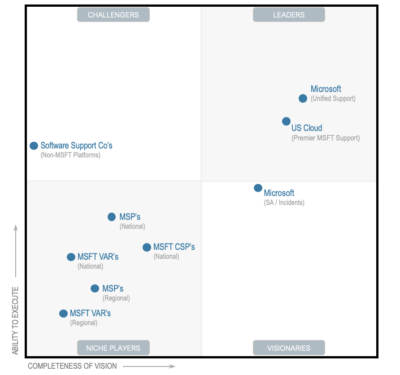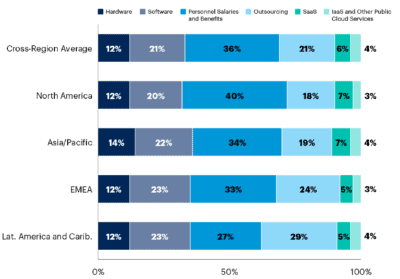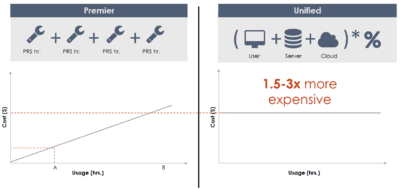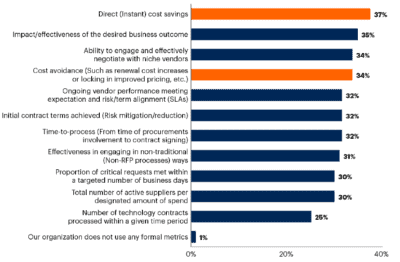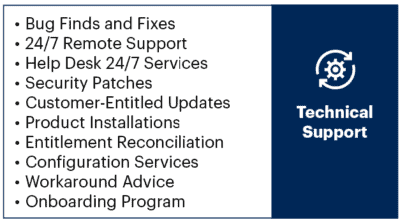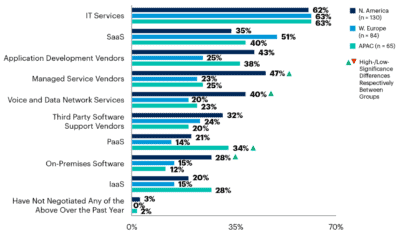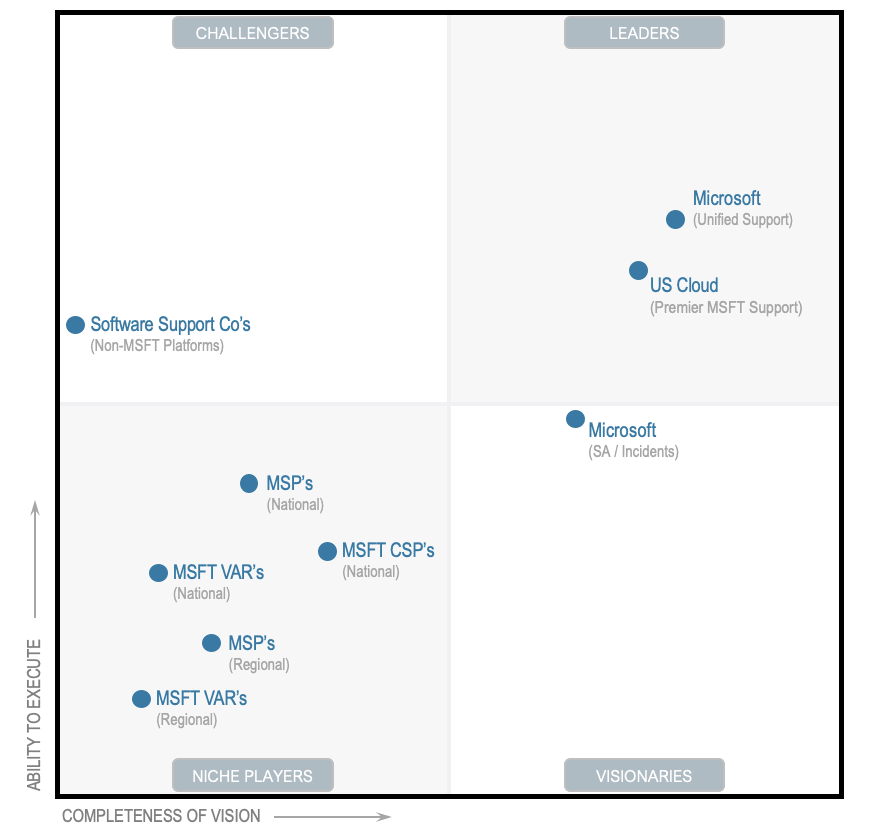
Q3 2021 Analyst Report – Microsoft Support Alternatives.
Q3 2021 ANALYST REPORT – MICROSOFT SUPPORT ALTERNATIVES
US Cloud identified again as the leading independent third-party support provider for Microsoft software with 50% savings.
Initiatives: Negotiating Microsoft Contracts | Strategic IT Cost Optimization
Audience: CIO and IT Executives | Sourcing, Procurement and Vendor Management
Microsoft Software 2nd Highest IT Spend Industrywide
Software is the 2nd highest IT spend category industrywide. 97% of the Fortune 500 rely on Microsoft software and are finding an unexpected 4-6% rise in their EA contract renewal due to escalating prices in Microsoft (Unified) support.
As a result, many enterprises are seeking guidance from analysts on how to better navigate Microsoft Premier/Unified support negotiations. Here are the latest findings and recommended tactics from the analyst community covering MSFT.
Key Microsoft Enterprise Software Support Findings
IT sourcing, procurement and vendor management officers looking for viable maintenance options for their Microsoft software are confidently positioned to recommend support cost optimization alternatives to their stakeholders.
Recommended Action 1 – Compare third party support policies and contract terms to Microsoft Unified (Premier) to reduce the risk of selecting a third-party provider with lower pricing but insufficient service.
Recommended Action 2 – Sourcing, procurement, and vendor management leaders can reduce cost and operational risk by engaging stakeholders during the Risk & Inspection phase.
Recommended to Evaluate MSFT Premier/Unified Alternatives
Step 1) Evaluate third party providers to reduce your 1.5 to 3x Microsoft support cost increase.
Step 2) Closely evaluate third party provider support policies and contract terms to your organization’s current Microsoft software contract.
Step 3) Send RFPs to all viable third-party providers to obtain information and pricing. Request at least one reference in your industry and a POC for the provider to showcase their service offering and support capabilities.
Microsoft Third Party Support Market Landscape
Third party support providers offer both cost-cutting and cost avoidance opportunities for organizations to reduce current and future year operating expenditure (opex) spend and budget. These capabilities should be evaluated as part of a feasibility study to analyze cost savings opportunities to reduce the rising maintenance and support fees from Microsoft.
Evaluate Third-Party Support to Help Fund Future Innovation
As software vendors focus investments on new cloud platforms, current, robust licensed applications receive less investment and fewer resources dedicated to support.
The significant savings from third-party support allows customers to fund digital transformation projects that they may be unable to deliver on while under vendor support. Customers can potentially move more quickly to innovate by removing the overhead and burden of vendor support.
Market Demand for Alternatives to MSFT Support
Analyst client inquiries related to software support for Microsoft increased more than 50% over the past 12 months with third party support market growth of 30% YoY for the past 5 years. Analysts predict continued growing interest as providers mature and expand service offerings.
Market Analysis of Third Party Microsoft Enterprise Support
In enterprises with significant Microsoft software portfolios, lower-priced third party support can offset a significant percentage of YoY annual maintenance and support increases typically imposed by Microsoft. Third party support deals make up more than 20% of all technology deals across North America, EMEA and APAC.
The COVID-19 pandemic has increased the velocity of interest and growth in third party support. In the first year of transition organizations see the savings as a quick win. Ongoing, the lower pricing helps to keep budgets flat when they’re challenged to meet cost-saving goals and initiatives.
Advantages of Using Third Party MSFT Support
Once a feasibility study is completed and the organization has decided to pursue third party support here are the substantial opex savings:
Reduce software budgets – specifically software maintenance (support) profit and loss (P&L) operating expense (opex). Average annual savings is typically around 50% for larger organizations when compared to the Unified Support pricing model of Microsoft.
Improved SLAs and specialized services such as Microsoft software development or customization.
Customized service agreements to meet an organization’s particular support needs such as fewer Designated Support Engineer (DSE) hour thresholds.
Use the lower-priced third party support provider’s proposal as leverage when negotiating with Microsoft.
Scenarios to Leverage Third Party Support for Microsoft Software
Cloud migrations – When version upgrades are no longer needed during cloud migrations, the third-party support provider can offer technical support for the customer entitled version so organizations can realize the average 50% cost reduction. This analysis should be part of the cloud migration planning checklist and total cost of ownership (TCO) analysis. Migration to alternative vendors or solutions – When new vendors or alternate solutions are selected to replace on-premises software products, third-party support can be analyzed to determine if a viable option is to use software with perpetual licenses under the customer-entitled version until the migration cutover date, and beyond, as necessary.
Low value, low volume technical support – The historical volumetric analysis of all help desk and service desk technical support and incident tickets should be analyzed every six months. This analysis helps to determine the ROI when comparing the value received to the annual cost paid for the Microsoft support service. This analysis should include the frequency of support calls, type of support, severity level, resolution time and results, and incident ticket close data for each of the software products in your MSFT portfolio.
Microsoft end of life – Situations can exist where older-version software is still being used to support certain applications, but will no longer be provided by MSFT without a customized support agreement and for an additional fee. Third-party support would not only result in the average 50% cost reduction compared to the current software vendor standard maintenance and support fees but avoid paying high customized professional service rates that Microsoft typically charges after the end-of-support date.
Support caps for price protection in contracts – In some cases, no price protection exists for ongoing maintenance and support in vendor contracts. In such cases, particularly with the three- to five-year term multiyear EA contracts, there is high risk of escalating maintenance and support costs or end-of-support announcements during these multiyear terms. If there is no price protection language in your contract, or if the price increase protection is higher than the current consumer price index (CPI) rate, third-party support services should be evaluated.
Reduce Waste in Your Microsoft Enterprise Agreement
CIOs are exploring using independent support as a way of freeing up significant operating budget with minimal risk. Two US Cloud clients reported that since switching from vendor support to US Cloud in 2021 they have saved 4-6% of their total MSFT Enterprise Agreement (EA).
They did this by reducing their Microsoft Premier (Unified) fees by 45 percent and moving the support portion out of the EA. CIOs that have freed up operating budget dollars in this way are using their surplus funds to hire key talent, innovate and launch strategic projects — and your company can do the same.
Market Guide for Independent Third-Party Support
Rising software maintenance and support costs are driving sourcing, procurement and vendor management leaders to explore the independent third-party support market for IBM, Microsoft, Oracle and SAP software.
To optimize costs, use this guide (Published August 23, 2021 ID G00734399) to evaluate alternative technical maintenance and support service offerings.
